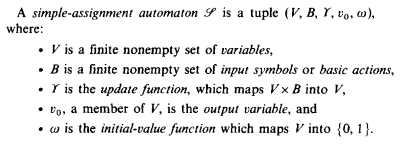I found a seminal paper of renowned authors (Inference of Finite Automata Using Homing Sequences (1993) by Ron Rivest and Robert Schapire) in which the authors define the very same set-theoretic concept twice but giving it two different names:
Information and Computation 103, 299-347 (1993)
p. 303:
p. 307:
Usually this is bad habit: defining the very same (set theoretic) concept twice but giving it two different names, especially in one single paper.
But the authors did, and they were aware of it:
My first question:
Why do they say "the structures appear to be quite similar" when they are obviously just identical?
What makes the difference - so the authors claim - is the interpretation:
On first blush, this is unsatisfactory. The difference in terms of interpretation seems deep and it seems to be possible to make it more explicit (e.g. in terms of model theory). It should not be left left to the reader to make it by "mental interpretation".
My second question thus is:
Did the authors probably (and correctly) assume that the reader interprets "interpretation" in the model theoretic sense and "fills in the gaps"?
How could/should the authors have made it better?




